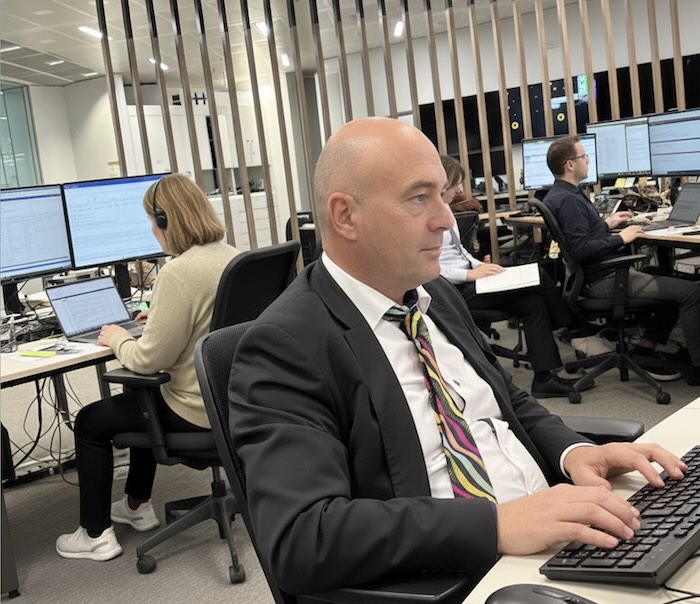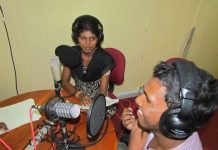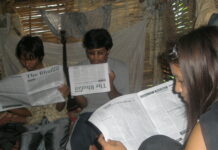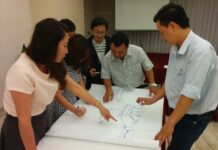 A hands-on editor should be visible and positive, lead well-prepared news meetings with strong communication skills, be present when big stories break, praise publicly, correct privately, and trust their staff.
A hands-on editor should be visible and positive, lead well-prepared news meetings with strong communication skills, be present when big stories break, praise publicly, correct privately, and trust their staff.
The title of this piece suggests I might know all the answers, which, of course, I don’t. There are always new tricks, even for an old dog like me, but no matter how times change there are some approaches that seemed to work – most of the time.
First of all, if you’ve got an office where you can shut yourself away, don’t use it. Of course it’s handy for tricky discussions or when you have some annoying budget report to write, but for the most part you should be in your newsroom.
In my last role as Editor-in-Chief at the Press Association (PA), I always sat on the news desk. It didn’t mean I was across every detail of what was happening, and sometimes I was writing one of those annoying reports. But people could see I was there, interested in what was happening around me and readily available for a quick decision or some guidance if required. I think that is really important and gives a strong message about your engagement with the job in hand.
You need to remember that other members of the team will always have half an eye on you. So things you do or say can quickly rub off on other people. If you arrive at work in a bad mood you need to shake yourself out of it, or you can soon drag everyone down.
Generally, I was happy for staff to hear me praising quality work, encouraging greater speed, or expressing disappointment if we were too slow, or got something wrong. But if any detailed discussion about poor performance was one for the editor’s office.
PA had news conferences twice a day, one at 0830 to make sure we were well set up, and another at 1530 to check we’d made good progress.
There would be news and sports editors at those conferences, as well as picture and video editors and various senior journalists from our specialist sections. More than enough, but I always made sure I was in place – and well-prepared – to lead the 0830 meeting.
That meant making sure I was up early enough to assess the day’s news agenda, look at our plans and what other media outlets were doing – newspapers, other news agencies, TV and radio stations.
When the 0830 meeting began I would feel ready for anything. I’d want to give a view of the things I felt we had done well – and not so well – the day before, and also comment on the data we had to show how customers had used our content.
Of course, different organisations have different amounts of data, but make good use of whatever you have. We changed a lot of our approaches simply by looking in detail at what customers were using the most, and dropping the things that never got onto their radars. And there is nothing more rewarding than guiding your journalists towards creating content that has more impact.
I always wanted to have a few ideas going into the conference. Too many morning meetings end up being a list of plans being read out, which would be easy enough to find in the editorial planning system. You can encourage the meeting to be a forum for ideas if you have some you can throw into the discussions. Sometimes it would be a question and answers format to help explain a complex breaking news story, a graphic to illustrate a business piece, a different way one of our photographers could tackle an assignment etc.
Not all the ideas would work, but the important thing was you could also encourage others to throw in their ideas too. And it’s another great feeling if one of those ideas can be celebrated the following day.
I would always make it clear if I felt one of my ideas had real merit, and that I wanted it done. The 1530 meeting was always a good way to check that the idea had been acted upon – and if not, making sure that everyone heard me ask ‘why not’?
Although my day-to-day work meant I was often doing something else while I was on the news desk, I have always made certain I knew how to operate the editing systems and could turn my hand to it if I had to on a really busy news day.
And if it was a big breaking news day – or a general election all-nighter – I’d make sure I was there helping on the news desk, and not tucked up in bed. If you expect your journalists to go the extra mile for you, it’s important you’re seen doing it too.
This knowledge of editing systems, and an ability to use them, has always felt important to me in the various leadership roles I’ve had. For a start, it’s helpful to show your teams that you are still a journalist and can write and sub-edit with the best of them.
But it goes further than that. You can always bang on about things being done more quickly or more efficiently, how to avoid mistakes while editing, and how to prioritise work more effectively. But you will do this with far less credibility if your teams know you don’t actually know how they work.
Communicating clearly and regularly with your teams, big or small, is vital. PA has journalists right across the UK and Ireland, so that was quite a task. I worked hard to visit as many of the teams as often as I could. I also sent an email every week to all staff – including non-editorial staff – giving them an update on what I had been doing, and also highlighting the best examples of our work being used by our many customers across newspapers, broadcasters and websites.
This fostered an environment where everyone could be proud of the work that PA did – and some of the most positive feedback I received was from people working in the likes of HR (human resources), finance, IT (information technology) and sales, who got a much better idea about what the all-important editorial operation was about. I also had an all-hands meeting/conference call with all editorial staff every month to ensure they were completely up to date with developments across our teams.
It was pleasing to celebrate successes in that weekly email, but equally important to make direct contact with journalists who had done a professional job. As mentioned before, if you are the editor the things you do have real weight – so a quiet ‘well done’ to someone at their desk, or calling or writing an email expressing your gratitude to a reporter away from the main newsroom was always time well spent.
But that doesn’t mean you are always Mr Nice Guy. While journalists at PA knew I would be very willing to praise, they also knew a phone call or face-to-face meeting – and ideally not an email – would be on the cards if they fell short of what was required. As the Editor of PA I was ultimately responsible for the quality of everything we produced, so I needed to behave that way at all times.
This might be starting to sound like I did everything. Far from it. The key to any of the successes we had at PA was the quality of the people I had around me. Establishing a management team of editors I trusted did not happen overnight, but after many years in the business it does not take long to spot the people who share your editorial values, have a good sense of humour, and the drive and energy required to always deliver.
Once you have that team, then the last thing you want to do is micro-manage them. I would meet each of my editors on a regular basis, and the key was for me to hear their ideas for their department and encourage them to get them over the line. I always wanted them to know I was there to help break down barriers if necessary – have a word with finance, brief HR, have a word with senior management – but that I trusted them to get on with it. Showing your trust in them is powerful, and it doesn’t have to be something earth-shattering.
Trust them, be there to fight the real battles for them, and also, crucially, if you have a really difficult problem to solve – like making the proposed budget balance for next year – share it with them and encourage them to help find the solutions for you. You may be the leader of the management team, but it’s a team.
And on those days when it all goes well, I was never afraid to join one of the editorial teams afterwards for a drink or bite to eat to say thank you. Similarly, attending leaving parties (in most circumstances) was something I always aimed to do, as well as summer and Christmas events. It’s always good to show your support at such things, but remember, you are the editor and you should make your excuses nice and early – there’s always the next 0830 conference to be thinking about.
So here are my top tips for a hands-on editor.
10 tips for a hands-on editor
- Be visible and available in the newsroom: Don’t hide in your office. Sit on the news desk to show you are engaged, interested, and readily available for quick decisions or guidance. This signals strong engagement with the job.
- Manage your mood and set the tone: Remember that staff are watching you. Arrive and maintain a positive, focused attitude, as your behavior and words quickly rub off on the team.
- Master the editorial systems: Maintain proficiency in the editing systems. Being able to step in on a busy day and demonstrating knowledge of the technical workflow gives you credibility when discussing speed, efficiency, and avoiding mistakes.
- Lead a well-prepared morning conference: Dedicate time early to assess the news agenda, review plans, and know what competitors are doing. Lead the morning meeting fully prepared to give a clear view and direction for the day.
- Create a culture of ideas and impact: Go into meetings with your own ideas to “throw into the discussions,” encouraging the conference to be a forum for creative thinking, not just a list of plans. Focus on creating content that has more impact.
- Use data to guide decisions: Make good use of whatever customer usage data you have. Be prepared to change approaches, drop low-performing content, and guide journalists towards more successful output based on these insights.
- Be present during high-stakes moments: When there is big breaking news, a general election, or an all-nighter, be there on the news desk helping. If you expect your journalists to go the extra mile, you must be seen doing it too.
- Praise directly, correct privately: Be happy for staff to hear you praise quality work and express disappointment in general performance (speed, errors). However, save detailed discussions about poor individual performance for the editor’s office.
- Communicate broadly and regularly: Maintain clear, regular communication with all staff (including non-editorial) through emails and all-hands meetings to update them on developments and highlight successful work.
- Trust and empower your management team: Establish a trusted team of editors and avoid micro-managing them. Be there to break down organisational barriers (finance, HR, CEO) but delegate the execution, showing that you trust them to deliver.








